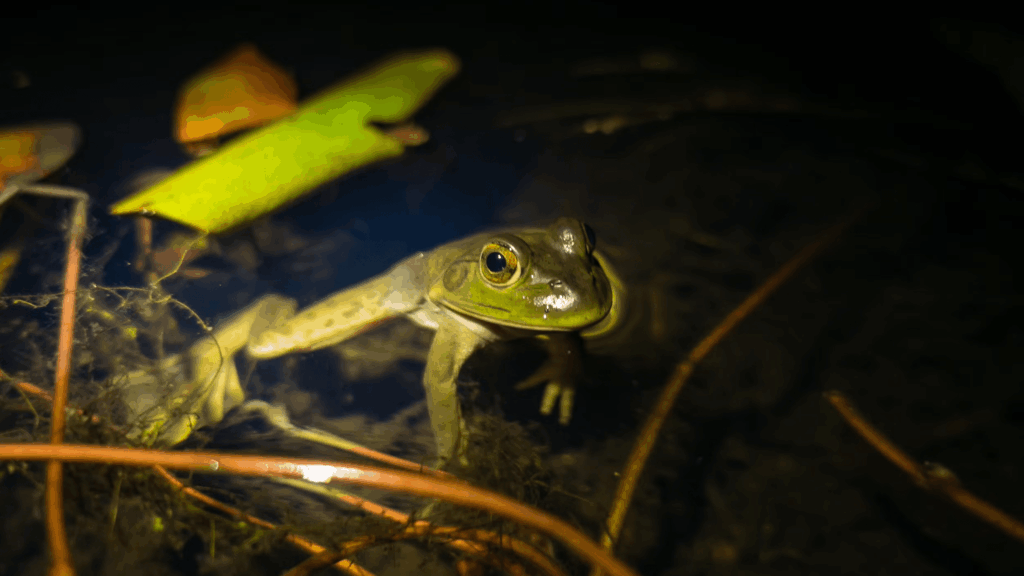Immersing yourself in the sounds of nature, like frogs croaking at night, may seem idyllic. However, when it comes to American bullfrogs in Yosemite National Park, California, the harmony is disrupted.
American bullfrogs (Lithobates catesbeianus) are large frogs originally from the eastern United States and are classified as invasive species in California. Introduced by humans in the 1950s, these bullfrogs quickly established themselves in Yosemite National Park within two decades.
According to Brian Todd, a professor at the University of California (UC), Davis’ Department of Wildlife, Fish, and Conservation Biology, American bullfrogs are renowned as one of the most detrimental globally introduced pests due to their voracious appetite, consuming anything that fits into their mouths.
The issue lies in the bullfrogs’ indiscriminate diet, which includes snakes, birds, rodents, and even baby turtles. Todd emphasized, “They’ve been causing declines to native species everywhere they’re introduced, which is around the world.”
Northwestern pond turtles (Actinemys marmorata) are among the two native freshwater turtle species in California and have experienced a significant population decline. To investigate the potential link between this decline and American bullfrogs, Todd and his team conducted a study.
Published in the journal Biological Conservation, the study focused on four native turtle habitats in Yosemite National Park, with two of them inhabited by American bullfrogs. The researchers observed that native turtles coexisting with bullfrogs were fewer in number, older, larger, and heavier compared to those in frog-free habitats, indicating a preference for adult turtles that are too large to be preyed upon by the bullfrogs.

Todd explains, “The current evidence indicates that bullfrogs are preying on young western pond turtles, preventing them from maturing into adults, ultimately leading to the decline of the turtle population.”
To test the impact of removing American bullfrogs on native turtle populations, the researchers initiated the eradication of the invasive species from both sites. The results were promising, as the removal of bullfrogs led to a resurgence in baby northwestern pond turtles.
[ Related: Discover the phenomenon of tiny toxic frogs falling from the sky. ]
Moreover, Sidney Woodruff, the lead author of the study and a ecology PhD student at UC Davis, noted, “As the bullfrog population decreased, we began to observe the presence of other native frogs and salamanders in the area, signaling a positive shift in the ecosystem.”
The study suggests that this proactive approach could be instrumental in conserving pond turtle populations in critical habitats where invasive bullfrogs are unlikely to reappear.
Todd emphasizes the importance of eradicating invasive species to preserve native ecosystems, prevent the extinction of endangered species, and safeguard human interests. Invasive species have the potential to disrupt the balance of ecosystems, outcompete native species, and pose threats to agriculture and public health.
When it comes to creating a unique and detailed article, there are several key factors to consider. Firstly, it is important to choose a topic that is both interesting and relevant to your target audience. This will ensure that your article captures the reader’s attention and keeps them engaged throughout.
Once you have chosen a topic, it is essential to conduct thorough research in order to gather all the necessary information. This may involve reading books, articles, and online sources, as well as interviewing experts in the field. By collecting a wide range of information, you will be able to provide a comprehensive overview of the topic and offer valuable insights to your readers.
In order to make your article stand out, it is important to present the information in a clear and engaging manner. This may involve breaking up the text with subheadings, bullet points, and images, as well as using a conversational tone to keep the reader interested. Additionally, including personal anecdotes or examples can help to make the article more relatable and engaging for the reader.
When writing a detailed article, it is crucial to provide evidence to support your claims and arguments. This may involve citing statistics, studies, or expert opinions to back up your points and add credibility to your writing. Additionally, providing links to additional resources or further reading can help to enhance the reader’s understanding of the topic.
In conclusion, creating a unique and detailed article requires careful planning, thorough research, and engaging writing. By choosing an interesting topic, conducting thorough research, and presenting the information in a clear and engaging manner, you can create an article that captures the reader’s attention and provides valuable insights on the topic at hand.


